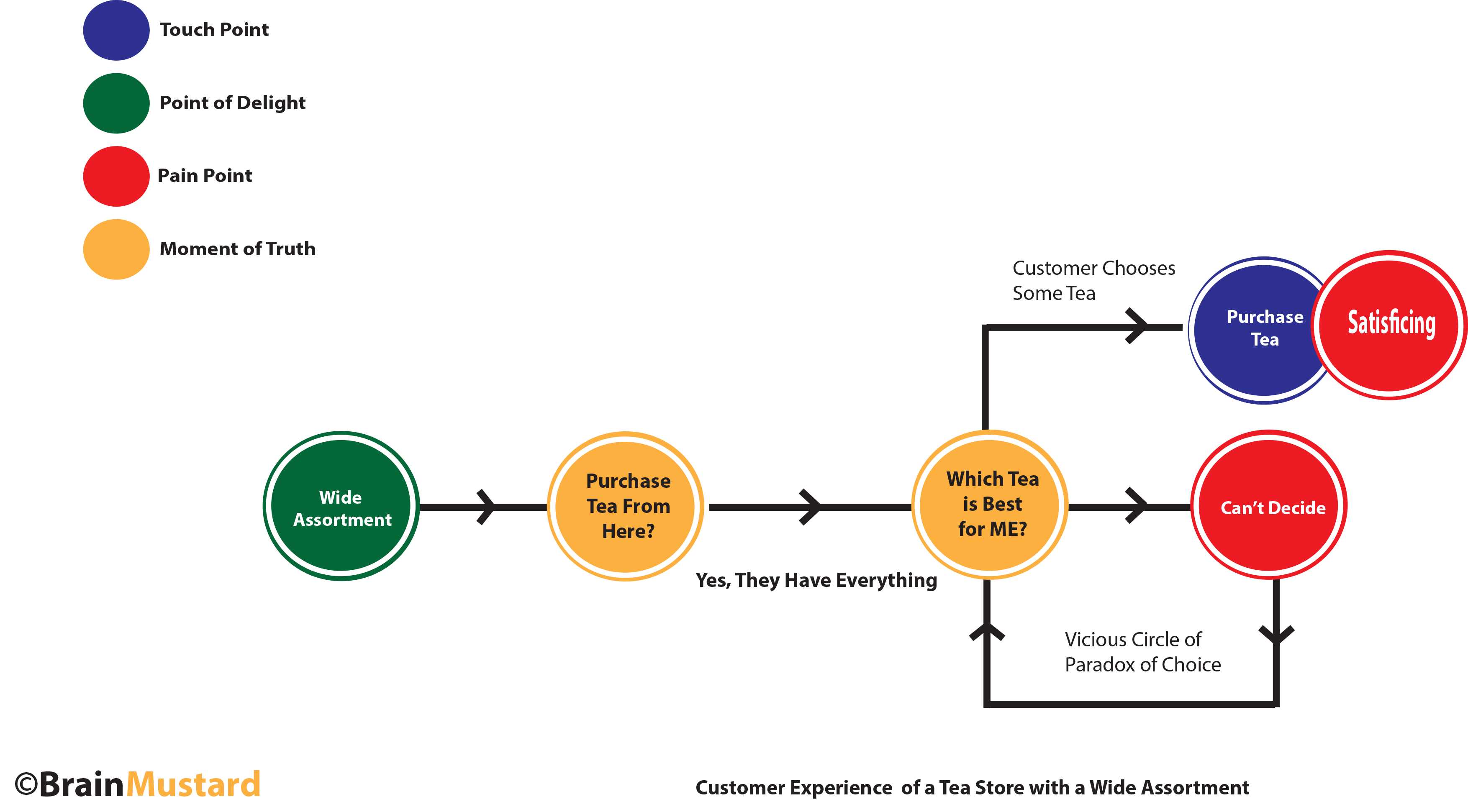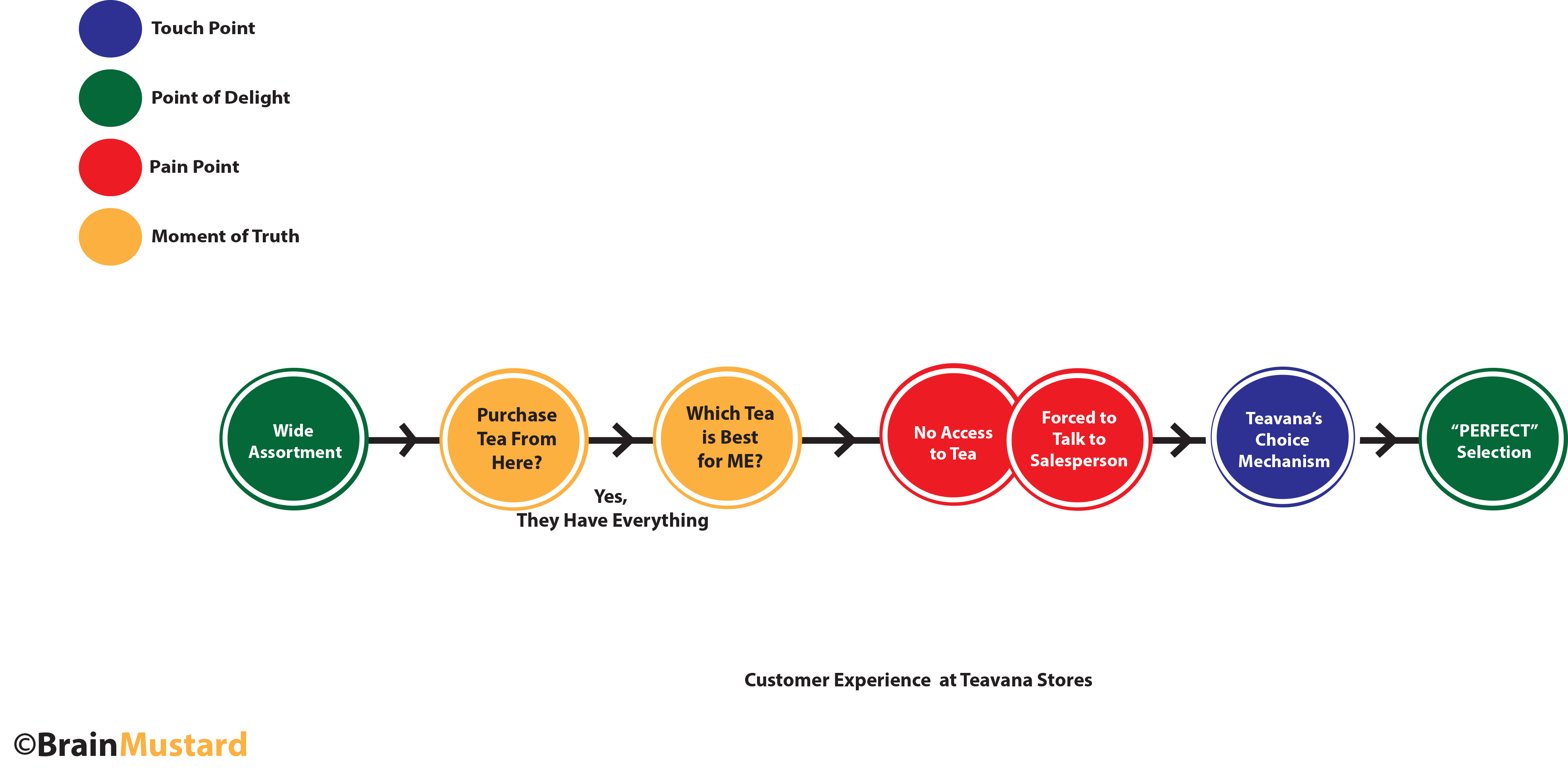Teavana and Paradox of Choice
BrainMustard Customer Experience Design Series
About this Article
The Customer Experience Series by BrainMustard are based on the customer experience maps and social influence graphs built from scanning and analyzing millions of contents from the Internet chatter.
These models and maps offer revealing and unexpected consumer insights to formulate new initiatives to increase sales. Check out our success stories at http://www.BrainMustard.com
Got a question?
- 10 Alcorn Ave. / #204 / Toronto / Canada
- 416-556-3909
- Contact@BrainMustard.com
Tweet
Teavana and Paradox of Choice
Pain points are by definition, well, unpleasant. You might think that anything considered a pain point should be the first priority for change. But not all pain points are bad. In fact, Some of them are necessary for a pleasant overall experience.
For example, most consumers perceive dealing with a salesperson a pain point, at least during the browsing phase of their shopping experience. They even lie to brush that sales person off.
***
However, the experience of shopping for tea in a Teavana store is different. Teavana is designed to be a "heaven of tea” - a combination of tea and nirvana. Upon entering the retail space you are met with a welcoming atmosphere. You’re surrounded by lovely gifts with modern packaging. Behind a large counter there’s a bright and cheerful sales staff ready to help. As you look up you are struck by an enormous wall with every flavour of tea imaginable.
In other words, a Teavana store is truly how one might imagine a heaven of tea. All of this sounds like a formula for an excellent customer experience, right? Wrong.
There’s a problem with too much choice.
***
Barry Schwartz presents the idea that we suffer psychologically when presented with too many options. Most of us think we’d rather have more rather than less. Thirty choices seems like a better deal than three. But often it’s not. Most of us are overwhelmed by too much choice. Schwartz argues that eliminating consumer choices can actually reduce anxiety for shoppers.
With this paradox of choice in mind, it's easy to understand how a shopper might experience negative karma when faced with a wall of tea. On your own, she might find a good enough tea. This behavior is known as satisficing. But satisficing is not particularly ecstatic and worthy to talk about.

Image: The Customer Experience of a Typical Tea Store with Wide Assortment. Despite Positive Touch Points, The Overall Experience is Unpleasant.
Teavana Way:
How does Teavana present the image of being a heaven of tea but also eliminate the pain point of cognitive overload? It introduces a choice mechanism.
In order to buy loose leaf tea from a Teavana retail location you must speak with a sales staff member. This, of course, violates retail gospel. In general, shoppers do not actually want to wait in line and speak with someone just to select and purchase some tea.
When you speak with a Teavana sales representative, she’ll ask a few questions. From your answers, she’ll be able to able to present you with something very pleasurable– a narrow group of choices. She’ll reduce the entire wall of options to three tea flavours selected just for you. Two of the options will reflect your taste profile. One will be an outlier, generally making your choice even easier.

Image: The Customer Experience of Teavana Stores with Wide Assortment. The Customer Experience is Delightful Despite The Frictions and Pain Points in the Middle.
***
Nice.
But wait, didn't you just have to talk to a person and have that person pretty much make the decision for you? And isn’t that a pain point?
Often it is a pain point, and in some stores it would be an annoying one. But here the pain point is really a solution to the anxiety of too many choices. Without providing choices, Teavana has no reason to exist. But providing so many choice leads to customer anxiety. The solution has to be to provide choice, create anxiety, and then solve the anxiety problem.
Will this work for all stores? Well, no. And that’s where customer experience mapping is important. A customer experience map puts the entire purchase process into perspective. It’s an invaluable tool for helping retailers know when a little pain will help the sale go down.
Tweet
Looking for similar articles from BrainMustard? Click Here
Copyright © BrainMustard
Pain points are by definition, well, unpleasant. You might think that anything considered a pain point should be the first priority for change. But not all pain points are bad. In fact, Some of them are necessary for a pleasant overall experience.
For example, most consumers perceive dealing with a salesperson a pain point, at least during the browsing phase of their shopping experience. They even lie to brush that sales person off.
However, the experience of shopping for tea in a Teavana store is different. Teavana is designed to be a "heaven of tea” - a combination of tea and nirvana. Upon entering the retail space you are met with a welcoming atmosphere. You’re surrounded by lovely gifts with modern packaging. Behind a large counter there’s a bright and cheerful sales staff ready to help. As you look up you are struck by an enormous wall with every flavour of tea imaginable.
In other words, a Teavana store is truly how one might imagine a heaven of tea. All of this sounds like a formula for an excellent customer experience, right? Wrong.
There’s a problem with too much choice.
Barry Schwartz presents the idea that we suffer psychologically when presented with too many options. Most of us think we’d rather have more rather than less. Thirty choices seems like a better deal than three. But often it’s not. Most of us are overwhelmed by too much choice. Schwartz argues that eliminating consumer choices can actually reduce anxiety for shoppers.
With this paradox of choice in mind, it's easy to understand how a shopper might experience negative karma when faced with a wall of tea. On your own, she might find a good enough tea. This behavior is known as satisficing. But satisficing is not particularly ecstatic and worthy to talk about.

Image: The Customer Experience of a Typical Tea Store with Wide Assortment. Despite Positive Touch Points, The Overall Experience is Unpleasant.
Teavana Way:
How does Teavana present the image of being a heaven of tea but also eliminate the pain point of cognitive overload? It introduces a choice mechanism.
In order to buy loose leaf tea from a Teavana retail location you must speak with a sales staff member. This, of course, violates retail gospel. In general, shoppers do not actually want to wait in line and speak with someone just to select and purchase some tea.
When you speak with a Teavana sales representative, she’ll ask a few questions. From your answers, she’ll be able to able to present you with something very pleasurable– a narrow group of choices. She’ll reduce the entire wall of options to three tea flavours selected just for you. Two of the options will reflect your taste profile. One will be an outlier, generally making your choice even easier.

Image: The Customer Experience of Teavana Stores with Wide Assortment. The Customer Experience is Delightful Despite The Frictions and Pain Points in the Middle.
Nice.
But wait, didn't you just have to talk to a person and have that person pretty much make the decision for you? And isn’t that a pain point?
Often it is a pain point, and in some stores it would be an annoying one. But here the pain point is really a solution to the anxiety of too many choices. Without providing choices, Teavana has no reason to exist. But providing so many choice leads to customer anxiety. The solution has to be to provide choice, create anxiety, and then solve the anxiety problem.
Will this work for all stores? Well, no. And that’s where customer experience mapping is important. A customer experience map puts the entire purchase process into perspective. It’s an invaluable tool for helping retailers know when a little pain will help the sale go down.
TweetLooking for similar articles from BrainMustard? Click Here
Copyright © BrainMustard